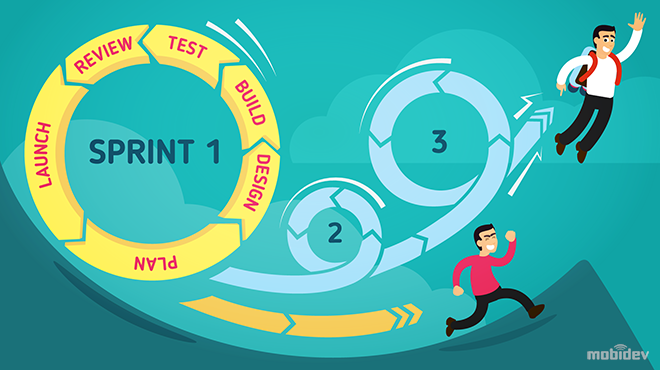A strategy is a roadmap for your company. It shows you the way to achieve your mission. However, the roadmap won’t do much if your car isn’t working. Take a look at all the recent trouble at Tesla and its Model 3.
Tesla needs to increase production of its Model 3 to meet market demand, and start making a profit for the first time in its history. However, it’s running into a myriad of problems. Tesla’s strategy and mission are clear, but it’s still messing up due to bad execution. For one thing, according to analysts, it seems to rely excessively on robots and automation. On top of that, it has a heavy debt load.
How can your business avoid a complicated situation like this?
For your mission and strategy to succeed, you need your company’s engine in shape: your people, systems, processes, and data and the way they work together to deliver products and services to customers.
Agile with solid foundations

Source: Skyscraper in Tokyo, inhabitat
In the olden days, things were pretty straightforward for a business. Your focus was mainly on achieving maximum efficiency in your end-to-end process and reducing costs. But the digital revolution is shaking everything up. On the one hand, business processes are increasingly complex, and on the other hand, the opportunities are greater as well.
The digital revolution has given access to incredible amounts of data and ways to connect with your customers. Better technology also means new possibilities for services and products. Still, to keep up with all the rapid changes, your competition, and new opportunities, your company’s architecture needs to become much agiler.
Compare it to a Tokyo skyscraper:
Your business needs to have strong business fundamentals, yet be agile enough to move with changes and significant disruptions in your environment, like a skyscraper swinging in an earthquake.
Set up agile teams
To get up to speed with changes, you need to make a turn towards an agile approach of working. Start by setting up your first agile teams. These teams are small and cross-functional. The agile team has everyone and everything they need to develop a working and tested part of a product or service.
An agile team is a great way of getting different backgrounds of knowledge around the same table. The team also involves their internal or external customers directly during the development process to quickly respond to and incorporate the customer’s needs and wishes.
TIP: Go big or go home: 6 steps to scale Agile up in your company
Align your teams with your mission

Source: Agile methodology: What is agility?
Your mission is your company’s destination. Your company should have a mission that inspires and is clear, concise and easy to remember for everybody. The army uses commander’s intent to briefly describes what success means for a given mission. The Army Field Manual 100-5 states about the commander’s intent:
‘Its utility is to focus subordinates on what has to be accomplished in order to achieve success, even when the plan and concept of operations no longer apply, and to discipline their efforts toward that end.’
By having your mission clear, your agile teams know what they should be working on. On a team level, they’ll develop a mission statement that shows how the team will help fulfill the company’s goals.
A clear mission statement will bring your company, its people, and resources into strategic alignment.
Test and release
The agile team utilizes an iterative process and experiments with small parts of the product. By rapidly trying out a new service or product with a customer you get immediate feedback. If the customer is not satisfied with the iteration, the team changes it or throws it out. By working like this, you respond flexibly to changes and the end-product will meet the customers’ needs. Furthermore, it will speed up your innovation cycle dramatically.
Failure is an option

Source: Unsplash
By releasing products quickly and essentially experimenting, there will be failure along the way, and that’s fine. Your company needs to understand this and encourage it. Start actively taking calculated risks by setting up small-scale test trials to try out new ideas. If a plan doesn’t work out; find out why to make the necessary changes and try again. Alternatively, cancel the project.
This way your team will soon discover what works and what doesn’t. You must structure and process the feedback data and actively use it to keep on advancing. By rapid testing, collecting and analyzing all the data, you’ll increase the agility of your business.
TIP: Don’t let negativity kill your business! 5 simple ways to stay positive
Set up a feedback system
Becoming agile means creating products and services which put customer value front and center. To do this, you need to process the feedback your customer gave you systematically. They took time out of their day to provide you with their feedback, so use it accurately. An excellent instrument for this is an automated closed-loop feedback system. The necessary 4 steps of a reliable feedback system are:
Receive Feedback
- The customer gives you feedback.
- The system processes the feedback and alerts the correct person.
Learn and Listen
- Contact your customer and ask what happened.
- Listen carefully and learn how to improve and innovate your business.
Fix it and make changes
- Fix the direct problem for your customer.
- Fix any root causes of the issue in your company.
- Make innovative changes.
Share
- Share the feedback and the lessons learned in your team and company.
- Hold regular feedback meetings with(in) teams.
This way you kill 2 birds with 1 stone. You’re improving your customer’s experience by listening and responding to them while also optimizing your company, products, and its services.
Create a reuse team

Source: Pixabay
As your agile teams will grow and your innovation takes flight, the benefits of reuse become evident. You don’t want the wheel to be reinvented 5 times within your organization. It’s a waste of resources. However, not every item can be or should be reused. For example, it might be too costly to adapt it for broader use, or it has many beginners errors in it.
To optimize your reuse, set up a dedicated reuse team. By systematically looking for reusable elements, you can maximize their value and save limited resources like time and money. Make sure your employees are aware of the team so that they highlight potential reusable assets to them.
The reuse team will go through these 4 steps:
- Find a reusable asset
- Check the viability of the asset
- Generalize the asset for broader use.
- Publish the asset and communicate it to possible users
To increase the potential reusability of elements, set up basic technical standards and have software in place which makes sharing and finding easy. Certain companies set up a reuse repository.
By taking these actions, you’re increasing your business agility, while at the same time, becoming more robust by focusing on what it is you want to achieve. This way, you’ll have your company’s engine roaring while driving on-route to the destination that you have set out.
We support businesses all over the world to become agile to better respond to changes. Contact us to find out what we can do for you.

